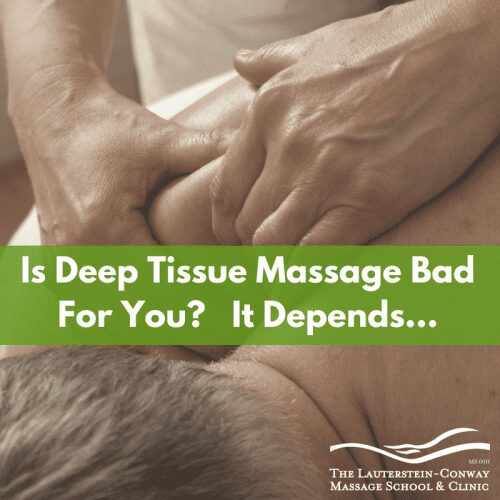Deep Tissue massage is often what people request these days. Many massage centers say deep tissue is different than “deep Swedish,” which is an overall massage done with deeper pressure.
But what exactly is deep tissue massage really? And is it bad for you?
What is Deep Tissue?
First, there’s no detailed definition for deep tissue massage – except we can say it uses more pressure than “regular” Swedish massage, and it’s currently in fashion.
Really, deep tissue is just a term for a variety of techniques used in a particular area of the body to address a specific problem.
And there are many massage modalities, other than deep tissue, that could also fit that definition. These modalities can focus on fascia, your body’s connective tissues, nervous system, bones and joints, circulatory systems, movement patterns, energy flow, etc.
Every one of these modalities. or any combination of them, may be the best answer to what is going on with you as an individual.
Deep Isn’t What’s Bad.
What is often limited and sometimes “bad” about deep tissue massage is the belief that massage, to be effective, has to hurt. The result of this belief is some deep tissue therapists actually bruise or injure their clients.
This is largely the result of incomplete education or insensitivity or both.
So deep tissue itself isn’t necessarily bad.
How Deep Tissue Massage Gets A Bad Wrap.
When you try to force people to change, you generate an equal and opposite reaction – resistance. Then you have a vicious cycle where you press hard, the client resists and hardens, so you press harder, and they resist more – even if they aren’t consciously aware of resisting!
To put frame an example in non-massage context, try arguing with your spouse and see if yelling helps them relax and change!
Pretty soon you have injured clients and often even injured therapists from trying over and over to overcome client’s natural resistance with force.
And deep tissue massage gets a bad wrap.
How Good Deep Tissue Massage Really Works.
What we teach at our school is that you cannot force someone or something in the body to relax.
The fact is people don’t relax until their nervous system tells them to. It’s like the lights in the house – they don’t turn on until you flip the switch to get the electricity flowing into them.
How do good therapists get that to happen?
- They observe your facial expressions, your breathing, any tensing up and they check in with you to make sure it’s feeling good yet deep.
- They educate you that to get rid of pain, more pain is not the best answer.
- They engage your neuromuscular system step-by-step; gradually increasing the pressure and pausing now and then to allow you time to let go more from inside out.
- You can feel they know their anatomy very well – as a result they don’t need to overwork to get results.
Studies have shown that the greatest predictor of therapeutic success is the healthy and safe relationship between therapist and client.
 At our school we teach both sensitive Deep Tissue and what we call “Deep Massage.” The latter very explicitly includes techniques and theories that recognize, if you want to affect someone deeply, you need to work with the whole person, not just thinking of them as a collection of tissues.
At our school we teach both sensitive Deep Tissue and what we call “Deep Massage.” The latter very explicitly includes techniques and theories that recognize, if you want to affect someone deeply, you need to work with the whole person, not just thinking of them as a collection of tissues.
For more information and techniques, join us for our next Deep Massage workshop.

